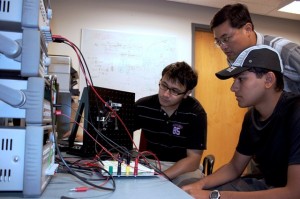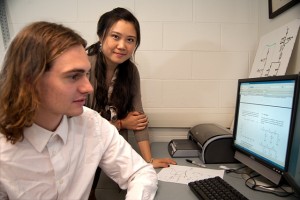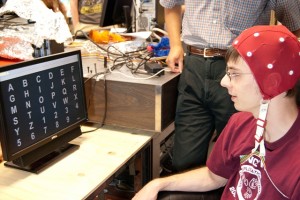Lafayette students have been putting their problem-solving skills to work combating health problems.
Ahsan Nawroj ’12, Chris Angeloni ’12, David Salter ’12, Yue “Luna” Yuan ’12, and Felix Hutchison ’12 presented research at the Biomedical Engineering Society (BMES) Annual Meeting, a three-day gathering where participants share work that advances human health and well-being.

From left, Ahsan Nawroj ’12, Shailesh Shrestha ’11, and Professor Yih-Choung Yu run a diagnostic test.
Nawroj (Dhaka, Bangladesh), an electrical and computer engineering major, has been working on his project for a year and a half. He got involved when Richard Koplin ’64—clinical associate professor at New York Eye and Ear Infirmary and owner of a small technology company—needed some engineers to complete a device and decided to tap into his alma mater. Yih-Choung Yu, associate professor of electrical and computer engineering, and Shailesh Shrestha ’11 have also worked on it.
The device is designed to help diagnose eye problems, which is particularly difficult when there is an obstruction like cataracts or blood. It gets around these obstacles by projecting sound into the eye and creating a map with the echoes. Nawroj’s job was to craft a microchip that controls the device’s motion.
Read more about the vision technology research
“The project was largely fueled by student ideas and gave me a chance to teach myself a lot of new skills and nifty techniques to achieve the larger goal,” says Nawroj. “I really enjoyed this ‘guided independence.’”
At the BMES conference, Nawroj enjoyed perusing the plentiful student-driven research. “I also got a chance to meet employers and graduate schools, who all had booths for students to visit,” he says.

Felix Hutchison ’12 and Yue "Luna" Yuan ’12 worked on a Grand Challenges project simulating neurons with electrical circuits in computer software.
Yuan (Wuhan, China), a mechanical engineering and policy studies double major, and Hutchinson, an electrical and computer engineering and mathematics double major, conducted their project through the Grand Challenges Scholars Program. Backed by the National Academy of Engineering, the program identifies 14 “grand challenges for engineering in the 21st century,” one of which is to “reverse engineer the brain.”
Yuan and Hutchinson tackled this by simulating neurons with electrical circuits in computer software. They devised a mathematical solution describing the neuron’s electrical output, then generated a circuit to produce that output, or act as the axon (the long, threadlike part of a nerve cell along which impulses are conducted from the cell). The complete model mimics a neuron’s electrical behavior. Such technology could be used to create a communication pathway between the brain and an electronic device.
Read more about the Grand Challenges project

David Salter ’12 demonstrates how the brain-computer interface works.
Angeloni (Sykesville, Md.), a neuroscience major, and Salter (Bethlehem, Pa.), an electrical and computer engineering major, combined their expertise to create a computer game with no joystick—only brainwaves. The project was funded by a faculty innovation grant from the Office of the Provost. The team also included Victoria Corbit ’13 (Reading, Pa.), a neuroscience major, Tony Lorence ’13 (Cumbola, Pa.), an electrical and computer engineering major, and faculty mentors Yih-Choung Yu and Lisa Gabel, assistant professor of psychology.
“Our project was based on BCI, or brain-computer interfaces. We recreated a system known as the P300 Speller, which uses the brain’s responses to a grid of characters in order to select the letter the user is focusing on,” says Angeloni. “In this way, the system allows the user to spell using merely thoughts.”
Using this system, the team created a virtual memory game that involves matching up cards. The technology has the potential to treat neurological diseases such as ALS, stroke, and paralysis, and to improve the lives of people with these conditions. The memory game could be used to help train patients to use other BCI technology.
Read more about the BCI project
Attending the BMES conference allowed Salter and Angeloni to meet up with others working with BCI technology—as well as to learn the ins and outs of presenting this work.
“The conference emphasized the need to explain your research in a way that others can understand and how to make your research pop out,” says Angeloni.


